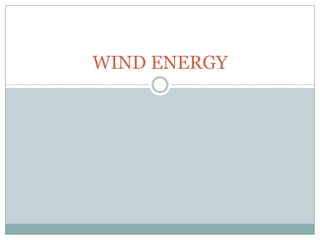
Wind energy
- 1. WIND ENERGY
- 2. "Coal, gas and oil will not be the three kings of the energy world for ever.
- 3. INTRODUCTION Energy is a major input for overall socio-economic development of any society The prices of the fossil fuels steeply increasing So renewable are expected to play a key role Wind energy is the fastest growing renewable Wind turbines are up to the task of producing serious amounts of electricity
- 4. What is a wind turbine? A device for converting wind energy into mechanical or electrical energy
- 5. How a Wind Turbine Works
- 6. Wind turbine converts kinetic energy of wind to rotary mechanical energy Blowing wind spins the blades on a turbine Blowing wind create a pocket of low pressure air forms on downside of the blades , which pulls blades towards it This is called Lift which cause the rotor to turn The rotor is connected to a shaft which causes a generator to makes electricity
- 7. TYPES OF WIND TURBINE THERE ARE BASICALLY TWO TYPES OF WIND TURBINES NAMELY: 1.HORIZONTAL AXIS WIND TURBINE(HAWT) 2.VERTICLE AXIS WIND TURBINE(VAWT)
- 8. HAWT
- 9. HAWT Advantages Variable blade pitch, which gives the turbine blades the optimum angle of attack. Allowing the angle of attack to be remotely adjusted gives greater control, so the turbine collects the maximum amount of wind energy for the time of day and season. The tall tower base allows access to stronger wind in sites with wind shear. In some wind shear sites, every ten meters up, the wind speed can increase by 20% and the power output by 34%. High efficiency, since the blades always move perpendicularly to the wind, receiving power through the whole rotation. In contrast, all vertical axis wind turbines, and most proposed airborne wind turbine designs, involve various types of reciprocating actions, requiring airfoil surfaces to backtrack against the wind for part of the cycle. Backtracking against the wind leads to inherently lower efficiency. 9
- 10. HAWT Disadvantages needs to be mounted on a high tower with high transport, installation & maintenance costs; very inefficient at low wind speeds; unusable at high wind speeds, so wasting the most useful high energy winds [Energy is proportional to wind velocity cubed]; environmentally problematic at the best locations; noise & RF interference; needs to be pointed at wind, which increases costs. 10
- 11. VAWT
- 12. VAWT advantages Lower construction cost Easier to maintain Lower wind start-up speeds Less likely to break in high winds Low height Does not need to turn VAWTs are quieter and interfere less with TV, radio & radar signals VAWT systems can also directly drive pumps which may be used to store wind generated energy. 12
- 13. VAWT disadvantages Current VAWTs are less efficient than HAWTs as some blades always oppose wind flow; Do not take advantage of the stronger wind at higher elevation as the HAWTs do. The stress in each blade due to wind loading changes sign twice during each revolution as the apparent wind direction moves through 360 degrees. This reversal of the stress increases the likelihood of blade failure by fatigue. While VAWTs' parts are located on the ground, they are also located under the weight of the structure above it, which can make changing out parts nearly impossible without dismantling the structure if not designed properly. Having rotors located close to the ground where wind speeds are lower due to wind shear, VAWTs may not produce as much energy at a given site as a HAWT with the same footprint or height. 13
- 14. Advantages of Wind Energy Clean fuel source Domestic source Renewable power Lowest priced renewable energy technology available today Benefits the economy
- 15. Disadvantages of Wind Energy Competition with conventional generation sources Good sites often remote from where electricity needed Concerns of noise and aesthetics impacts Environmental Concerns i.e. Birds
